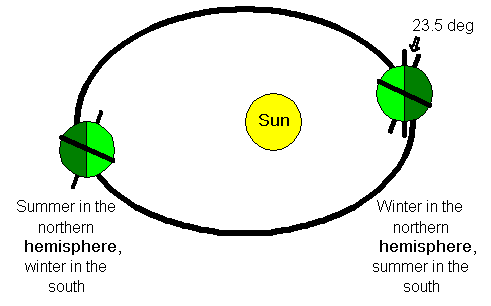
Kepler's First Law tells us that the orbits of all the planets are ellipses. An ellipse (a sqashed circle) has two focii and the sun is located at one focus of the ellipse. In the case of the Earth the ellipse is very close to being a circle. If the average radius of the Earth's orbit (93 million miles) is thought of as 100% then the shortest radius is 98% and the longest radius is 102%.
The point at which the Earth is nearest to the Sun is known as the Perihelion and the point at which it is furthest away is known as the Aphelion.

The image above (not drawn to scale) shows the Sun at the focus on the right. The left focus is not marked as there is nothing there. The aphelion is on the left side of the orbit and the perihelion is on the right.
The Earth leans on its axis at an angle of 23.5 degrees. When the Earth leans away from the Sun the northern hemisphere has winter. This is at the perihelion which means that the northern hemisphere is actually nearer the Sun when the weather is coldest. When the Earth is at its aphelion (left side of drawing) the northern hemisphere has summer and the Sun is higher in the sky.
The effect of Kepler's Second Law is that the Earth travels at different speeds at different parts of its orbit. At the perihelion it is going at its fastest and at the aphelion it is going at its slowest. This is not noticeable to us but it may be some comfort to those who live in the northern hemisphere that winter is slightly shorter than summer!
The time of perihelion slowly regresses (moves later) by 25 minutes each year, making a full cycle through the tropical year in approximately 21,000 years. The angle of tilt (or obliquity) of the earth also changes. This cycle takes 41,000 years and at 23.5 degrees the present figure is roughly mid-way between the two limits. These two cycles are known as the Malankovitch Cycles and may have some influence on the worlds climate in the long term.
 Home page
Home page